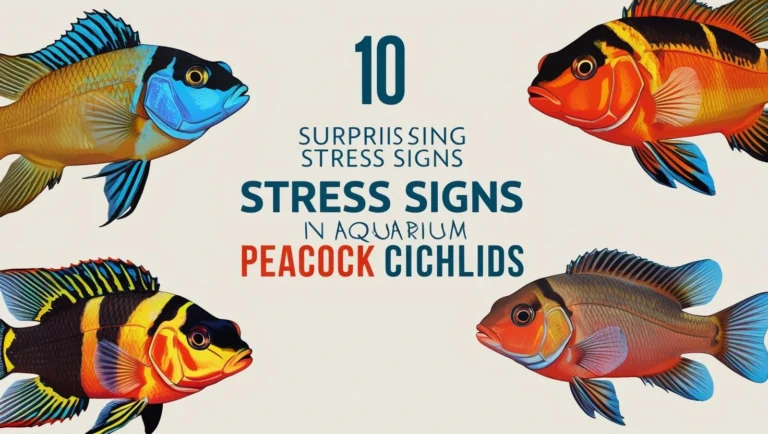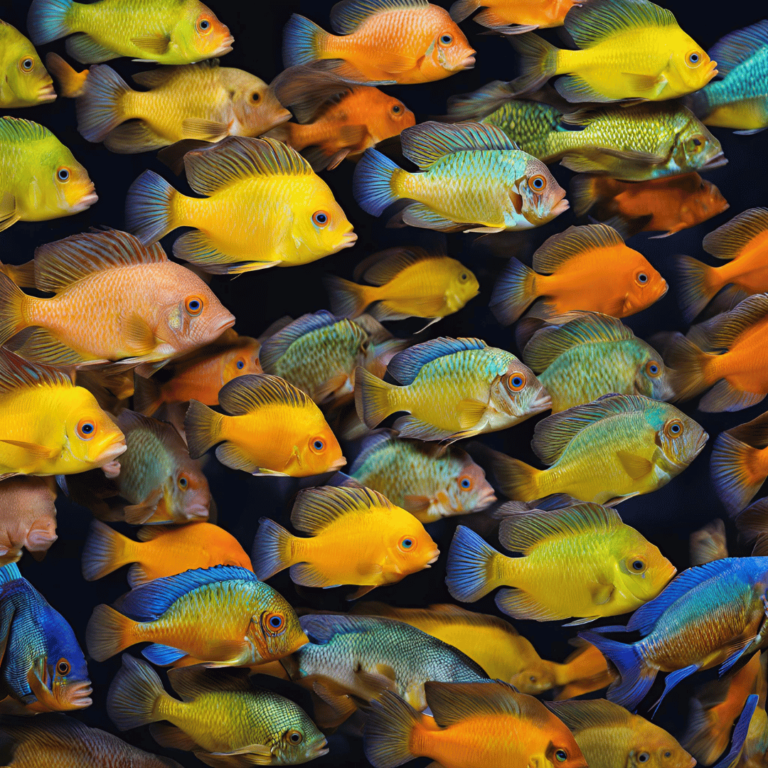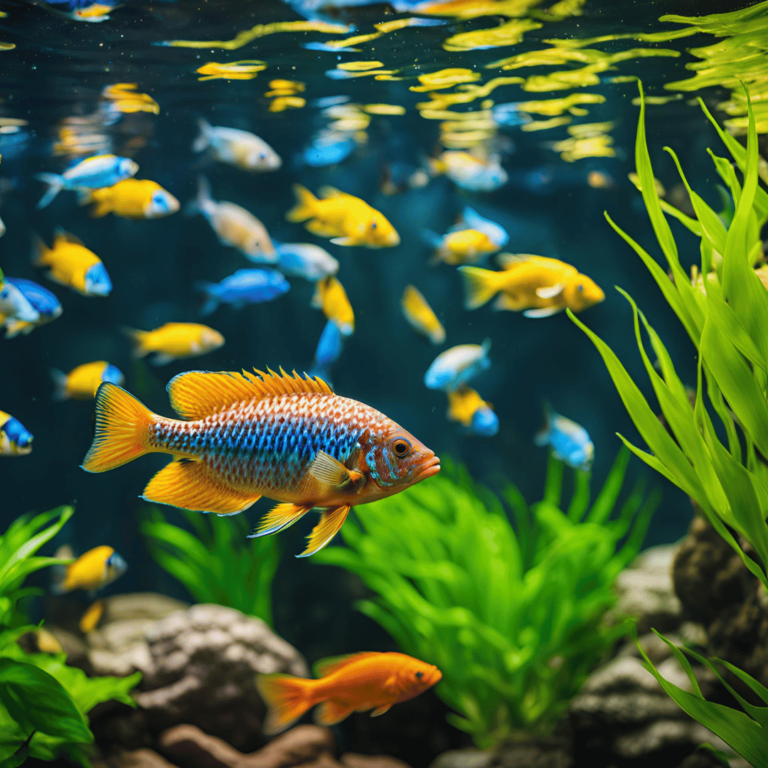Your trusted guide to cichlid care, tank setups, and quality products.

Peacock Cichlid pH Stability: 10 Powerful Steps for Success
Ensure optimal water conditions for your peacock cichlids by understanding the importance of pH levels! Our guide provides insights into the ideal pH range, testing methods, and tips for maintaining stability. Create a healthy and thriving environment for your fish.
Image credits Canva
Peacock Cichlid pH Stability is critical to creating a thriving and healthy tank environment for these vibrant, colorful fish. Native to the alkaline waters of Lake Malawi, Peacock Cichlids require consistent and stable pH levels to remain stress-free, healthy, and full of brilliant color. This guide explores the importance of pH stability, factors that influence it, and actionable strategies to achieve and maintain optimal pH levels in your aquarium.
At PeacockCichlid.com, we believe in transparency and honesty with our readers. Some of the links in this article are affiliate links, which means we may earn a small commission if you make a purchase through them—at no additional cost to you. These commissions help support our site, allowing us to continue providing expert advice, in-depth guides, and valuable content for Peacock Cichlid enthusiasts like you.
We only recommend products that we trust and believe will be beneficial for your aquarium. Thank you for your support!
Why Peacock Cichlid pH Stability Matters
The health, appearance, and overall behavior of Peacock Cichlids depend heavily on maintaining proper water conditions. Peacock Cichlid pH stability ensures:
- Stress Reduction: Stable pH prevents stress, which weakens the immune system and makes fish prone to disease.
- Improved Health: Irregular pH can disrupt bodily functions, causing lethargy, erratic behavior, and overall poor health.
- Vibrant Colors: Stress caused by pH swings often leads to dull, faded colors in Peacock Cichlids.
By achieving pH stability, you promote the longevity and vibrancy of these stunning fish, helping them thrive in your aquarium.
Understanding Peacock Cichlid pH Stability
Peacock Cichlids thrive in slightly alkaline water with a pH range of 7.8 to 8.6, mirroring the natural conditions of Lake Malawi. Small fluctuations can cause significant stress, leading to long-term health issues. Monitoring and maintaining consistent Peacock Cichlid pH stability is essential for their overall well-being.
Natural Habitat Insight
Lake Malawi, the natural home of Peacock Cichlids, is known for its crystal-clear waters, high mineral content, and stable pH. Recreating this environment in your aquarium requires careful planning and attention to detail. The stability of these conditions is as important as the range itself, as even small changes can disrupt the delicate balance.
Top Factors Affecting Peacock Cichlid pH Stability
- Water Source and Quality
- The pH of your water source can vary significantly. Test your tap or well water before using it in your tank. If it’s too acidic, use buffering agents or alkaline additives to match the required range.
- Consider using Reverse Osmosis (RO) water with remineralization to have greater control over your aquarium’s water chemistry.
- Substrate Choices for Stability
- The substrate plays a key role in Peacock Cichlid pH stability. Use materials like crushed coral, aragonite sand, or limestone. These substrates naturally raise and stabilize pH levels over time.
- Avoid substrates that lower pH, such as peat moss or certain soft sands.
- Tank Decorations
- Certain tank decorations, like driftwood, can leach acids into the water, lowering pH levels. Opt for decorations that maintain alkaline stability, such as Texas Holey Rock or inert rocks.
- Decorations should also be easy to clean, as algae buildup can impact water chemistry over time.
- Filtration and Aeration
- A strong filtration system supports Peacock Cichlid pH stability by promoting gas exchange, balancing CO2 levels, and controlling ammonia and nitrates.
- Proper aeration reduces CO2 buildup, which can lower pH. Use air stones or powerheads to maintain efficient gas exchange.
- Aquarium Plants
- Live plants affect pH levels through their respiration cycles. During the day, plants absorb CO2 and raise pH, while at night, they release CO2, causing minor drops.
- Balance planting to minimize large fluctuations and choose species compatible with alkaline water, such as Vallisneria or Anubias.
- Water Changes
- Frequent water changes can disrupt Peacock Cichlid pH stability if new water pH differs from the tank. Pre-condition and test the pH of replacement water to match the aquarium’s existing levels.
- Gradual changes are key to preventing sudden stress on your fish.
- Bioload Management
- The bioload, or the amount of waste produced by fish and organic matter, directly influences water quality. Excess waste can lead to pH changes. Regular tank maintenance, such as cleaning filters and removing uneaten food, can mitigate these effects.
- Temperature Effects
- Water temperature can subtly affect pH levels. Ensure that your aquarium heater maintains a consistent temperature in the range suitable for Peacock Cichlids (76–82°F).
How to Test and Monitor Peacock Cichlid pH Stability
Regular testing is the foundation of maintaining stable water conditions. Here’s how to monitor Peacock Cichlid pH stability effectively:
- Test Regularly: Check pH levels weekly and after water changes.
- Record Results: Maintain a log to track pH trends and identify any fluctuations.
- Respond Quickly: Address deviations promptly to reduce stress on your fish.
Recommended Tools for pH Testing:
- Liquid Test Kits: Affordable, accurate, and easy to use.
- Digital pH Meters: Provide precise readings but require occasional calibration.
- Test Strips: Convenient for quick checks but less accurate.
Additional Monitoring Tips:
- Test during different times of the day to understand diurnal pH fluctuations.
- Ensure test kits are not expired, as old reagents can give inaccurate results.
10 Steps to Maintain Peacock Cichlid pH Stability
- Use Buffering Agents: Add commercial pH buffers or baking soda to stabilize pH within the desired range.
- Incorporate Crushed Coral or Limestone: Adding crushed coral or limestone to the substrate naturally increases and stabilizes pH levels.
- Choose Alkaline Tank Decorations: Decorations like Texas Holey Rock or aragonite-based rocks release minerals that support Peacock Cichlid pH stability.
- Adjust Water During Changes: Pre-treat new water to match the aquarium’s pH levels to prevent sudden shifts that can stress your fish.
- Improve Aeration: Enhance gas exchange by using air stones or additional filtration to reduce CO2 levels, stabilizing pH.
- Use Specialized Water Conditioners: Conditioners designed for African Cichlid tanks neutralize harmful substances while maintaining alkaline water.
- Monitor Substrate Health: Replace or supplement substrate like crushed coral when its buffering capacity diminishes over time.
- Maintain Consistent Filtration: Biological and mechanical filtration keeps water chemistry stable and prevents harmful pH swings.
- Avoid Overfeeding: Excess food decomposes into ammonia, altering pH levels. Feed moderate portions to prevent waste buildup.
- Prevent Overcrowding: Overcrowding increases bioload, disrupting water stability. Maintain ideal stocking levels for a healthy environment.
Troubleshooting Common Peacock Cichlid pH Problems
- pH Too Low: Add crushed coral, limestone, or buffering agents gradually to increase pH.
- pH Too High: Identify the cause, such as excess minerals, and perform partial water changes with slightly lower-pH water.
- Frequent Fluctuations: Evaluate water source, substrate, and decorations to address instability.
Advanced Tips for Troubleshooting:
- Observe Fish Behavior: Lethargy, color fading, or erratic swimming often signal pH instability.
- Use Stability-Boosting Products: Invest in commercial products tailored to African Cichlid pH needs.
- Test CO2 Levels: Excessive CO2 lowers pH; ensure proper aeration and gas exchange.
Preventative Measures:
- Regularly clean the tank to remove organic waste.
- Test tap water seasonally, as municipal water supplies may vary throughout the year.
Final Thoughts: Master Peacock Cichlid pH Stability
Achieving perfect Peacock Cichlid pH stability is essential to maintaining a thriving, colorful, and stress-free tank environment. By understanding the factors that influence pH, using proven stabilization methods, and monitoring conditions regularly, you can replicate the pristine alkaline waters of Lake Malawi.
Creating an optimal environment for your Peacock Cichlids ensures their health, happiness, and vibrant beauty. Share this guide with fellow enthusiasts to help others master the art of Peacock Cichlid pH stability and build a strong, informed aquarist community.
To further enhance your aquarium’s water quality and overall fish health, be sure to explore more expert insights on peacochcichlid.com. For instance, our guide 7 Expert Tips to Maintain Water Quality for Peacock Cichlids offers practical strategies for sustaining an optimal environment, while 10 Signs of Peacock Cichlid Stress and How to Prevent It can help you quickly identify and address potential issues before they escalate. Additionally, check out Top 7 Common Peacock Cichlid Diseases and Prevention Tips for essential advice on keeping your fish healthy and vibrant.
We’re constantly updating our site with new tips and expert advice, so visit us again for more insights and be sure to follow us on social media to stay connected with the latest trends in peacock cichlid care!
FAQ’s
What is the ideal pH range for Peacock Cichlids?
The ideal pH range for Peacock Cichlids is between 7.8 and 8.6, replicating their natural Lake Malawi habitat.
How often should I test the pH levels in my tank?
You should test the pH levels at least once a week and after water changes or adding new decorations.
Can I use tap water for my Peacock Cichlid tank?
Yes, but test and condition the tap water to ensure it matches the optimal pH range before adding it to the tank.
How does crushed coral help with Peacock Cichlid pH stability?
Crushed coral releases calcium carbonate into the water, gradually increasing and stabilizing pH levels.
What happens if the pH drops too low?
Low pH can cause stress, health issues, and dull colors. Use buffering agents or add limestone or crushed coral to raise pH gradually.
Can live plants affect Peacock Cichlid pH stability?
Yes, plants can cause slight pH fluctuations due to their respiration cycle. Balance the number of plants to minimize these changes.
What decorations are best for stabilizing pH?
Alkaline decorations like Texas Holey Rock, aragonite rocks, and limestone are ideal for maintaining pH stability.
How do I prevent pH swings during water changes?
Always pre-test and adjust new water to match the tank’s existing pH before performing water changes.
Can overcrowding impact pH stability?
Yes, overcrowding increases bioload, leading to waste buildup and pH instability. Maintain proper stocking levels.
What is the best method to raise pH gradually?
The safest methods include adding crushed coral, limestone, or using pH buffers while monitoring levels closely.



